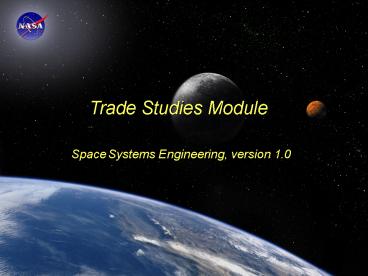Trade Studies Module Space Systems Engineering, version 1.0 - PowerPoint PPT Presentation
1 / 33
Title: Trade Studies Module Space Systems Engineering, version 1.0
1
Trade Studies Module Space Systems Engineering,
version 1.0
2
Module Purpose Trade Studies
- Describe the typical trade study process and show
an example. - Recognize that trade studies support decision
making throughout the project lifecycle. - Provide some trade study heuristics to improve
the application and value of future trade
studies. - Describe and provide a trade tree - an option
management graphic.
3
What is a Trade Study?
- A trade study (or trade-off study) is a formal
tool that supports decision making. - A trade study is an objective comparison with
respect to performance, cost, schedule, risk, and
all other reasonable criteria of all realistic
alternative requirements architectures
baselines or design, verification,
manufacturing, deployment, training, operations,
support, or disposal approaches. - A trade study documents the requirements,
assumptions, criteria and priorities used for a
decision. This is useful since new information
frequently arises and decisions are re-evaluated.
4
Trade Studies Support Decision Making Throughout
the Development Lifecycle
- Trade studies support
- Requirements development - e.g., to resolve
conflicts to resolve TBDs and TBRs - Functional allocations - e.g., system
architecture development - System synthesis - e.g., assess the impact of
alternative performance or resource allocations - Investigate alternate technologies for risk or
cost reduction - Assess proposed design changes
- Make/buy decisions (i.e., build the part from a
new design or buy from commercial, existing
sources)
5
The Trade Study Process (1/2)
- Define the objectives of the trade study
- Review inputs, including the constraints and
assumptions - Choose the evaluation criteria and their relative
importance (these can be qualitative) - Identify and select the alternatives
- Assess the performance of each option for each
criteria - Compare the results and choose an option
- Document the trade study process and its results
6
The Trade Study Process (2/2)
7
Evaluation Criteria Measures (1/2)
- Trade studies depend upon having criteria for
making decisions based on measures of
effectiveness (voice of the customer) and
measures of performance (voice of the engineer). - Measure of Effectiveness (MOE) - A measure of how
well mission objectives are achieved. MOEs are
implementation independent - they assess how
well not how. - Example measures of effectiveness include
- Life cycle cost
- Schedule, e.g., development time, mission
duration - Technology readiness level (maturity of
concept/hardware) - Crew capacity
- Payload Mass
8
Evaluation Criteria Measures (2/2)
- Measure of Performance (MOP) - A quantitative
measure that, when met by the design solution,
will help ensure that an MOE for a product or
system will be satisfied. There are generally two
or more measures of performance for each MOE. - Example measures of performance
- Mass
- Power consumption
- Specific impulse
- Consumables required
- Propellant type
- Both MOEs and MOPs are system figures of merit
an MOE refers to the effectiveness of a solution
and an MOP is a measure of a particular design.
9
Trade Study Heuristics
- Rules of Thumb
- Manage the number of options under consideration
- Revisit the original problem statement
- If a baseline solution is established, use it as
a yardstick to measure the alternatives. - Decisions are frequently made with imperfect
information. - Do not get stuck in analysis paralysis.
- Decide how deep the analysis must go. Deep
enough to make a decision with confidence, but no
deeper. - Does the decision feel right? If not, why?
- Conduct further what-if scenarios by changing
assumptions. - Reject alternatives that do not meet an essential
requirement. - Ignore evaluation criteria that do not
discriminate between alternatives. - Trades are usually subjective numeric results
usually give a false sense of accuracy. - If an apparent preferred option is not decisively
superior, further analysis is warranted.
10
Example Decision Matrix Trade Study
Preferred Solution
11
Example Qualitative Decision MatrixFor a Lunar
Thermal Control Trade Study
Characteristics Single Phase Fluid Two Phase Fluid Heat Pipe
Safety (3) Operating Pressure Low High Low-Medium
Safety Toxicity Fluid Dependent Fluid Dependent Fluid Dependent
Safety Flammability Fluid Dependent Fluid Dependent Fluid Dependent
Reliability (1) High Fair Fair
Performance (2) Pumping Cost Low High Fair
Complexity (4) Controls Simple Nominal Complex
Complexity (5) Manufacturing Difficulty Simple Nominal Complex
12
Do A Reality Check On The Tentative Selection
- Key questions to ask
- Have the requirements and constraints truly been
met? - Is the tentative selection heavily dependent on a
particular set of input values and assumptions,
or does it hold up under a range of reasonable
input values (i.e., is it robust)? - Are there sufficient data to back up the
tentative selection? - Are the measurement methods sufficiently
discriminating to be sure that the tentative
selection is really better than the alternatives? - If close results, is further analysis warranted?
- Have the subjective aspects of the problem been
fully addressed? - Test the decision robustness.
- Is the tentative selection very sensitive to an
estimated performance or constraint? If so,
explore the full reasonable range of each
performance variable to understand the domain
where your tentative selection is appropriate.
13
Trade Trees
- A trade tree is a graphical method of capturing
alternatives with multiple variables. - Each layer of the tree represents some aspect of
the system that will be treated in a trade study
to determine the best alternative. - Some alternatives can be eliminated (or pruned)
a priori because of technical feasibility, launch
vehicle constraints, cost, risk or some other
disqualifying factor. - The total number of alternatives is given by the
number of end points of the tree. - Even with just a few layers, the number of
alternatives can increase quickly, so manage
their numbers.
14
Top-level Trade Tree-Example for Mars
- 1988 Mars Expedition































